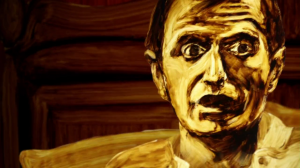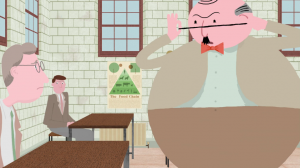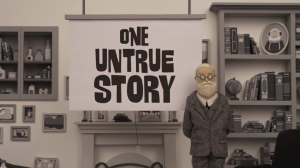A Liar’s Autobiography: The Untrue Story of Monty Python’s Graham Chapman
Written by Emmett Goodman and Written by Trisitian Goik
[youtube http://www.youtube.com/watch?v=dbW842eMNtI&w=560&h=315]
Well, in all honesty, I don’t like very long film titles. But if there was one that summed up an entire movie precisely, it is this. A Liar’s Autobiography is a multi-animated romp through the life of Graham Chapman. Based upon Graham Chapman’s own autobiography, the film is directed by Bill Jones, Ben Timlett, and Jeff Simpson, and is produced with 14 different animation studios. We were recently treated to a special American viewing in New York at the (current) Paramount Theater, complete with 3D glasses that surprisingly worked.
For anyone familiar with the history of Monty Python, Graham Chapman’s individual history is particularly sordid compared to his fellow Pythons. Don’t get me wrong, they’re all flawed (aren’t we all), but Chapman’s flaws are accounted by others to include hedonism, severe alcoholism, arrogance, and…oh yeah…he’s the only dead Python so far. He was also known for his bad timing, driven to the point when he died of throat cancer on the eve of Monty Python’s 20th anniversary in 1989. Chapman’s voice is at the center of the film, taken from recorded readings of his own autobiography sometime before his death.
Although four of the surviving Pythons lend their voices to the film (Eric Idle is absent for some reason), only John Cleese portrays himself. This is no surprise as Chapman and Cleese were writing partners since their days at Cambridge, and Cleese was probably closer to Chapman than the rest. John Cleese performs his lines with Graham’s dialog in what could said to be their first collaboration in nearly 30 years. Such a moment.
This is actually a sad movie we are compelled to laugh at. There is a scene depicting Chapman’s “Coming-Out” Party, showing the reactions of his friends. One reaction that gets a tragic laugh is when English actor Marty Feldman, whom Chapman worked with in the late 60s, laughs so hard at the revelation that he collapses. Morbidly amusing, considering Feldman predeceased Chapman by heart-attack in 1982.
The film becomes even sadder as Graham’s account of his alcoholism becomes more remorseful. It is known that Graham was forced to face his drinking when he found himself in an dry county while filming Monty Python and the Holy Grail. His self-imposed detox is illustrated with a dark nightmare sequence, presented in an experimental-paint animation (courtesy of London-based Tundra*). Director Jeff Simpson sums it up pretty clearly: Graham Chapman was an open-homosexual, but secretly was an alcoholic.
There is a rich taste of peculiar British humor in this bio-pic of a gay icon. For some reason the promotional packet and director’s statements are very insistent that this is “not a Monty Python film.” I mean, come on: “don’t think of elephants.” People don’t have to clarify that a documentary about the Beatles is not a “Beatles film.” If the directors were so concerned about it, they could have added that clarification to their already too-long film title, or just cut the “Monty Python’s” adjective from his name if they wanted to distance themselves. Anyway, I found the friendship between Chapman and Cleese (and the other Pythons) very touching, particularly in the funeral service. The animation brings out the emotions that are hidden beneath the surface of the comedy sketches and reveal a very thorough examination of one man’s wrestle with sexuality and drink. All in all, his life was not that terrible. He did have a long time boyfriend, and he was able to bring himself out of his addiction. Graham Chapman was a very sexy man, and a great actor. He took complete control over the presentation of his own life through his book and recordings. And he probably met death with grace and steel.
If there was ever an individual who could confound someone on the issue of sex, it was Graham Chapman. Graham’s account of the pros and cons of promiscuous sex is suitably delusional. Among his many (self) claims-to-fame is his blunt openness about his homosexuality in the late 1960’s, at a time when it was seldom being accepted in Western culture. Although it is not the first R-rated animated feature film, it comes a little close to being the first NC-17 rated animated feature. Graham’s recollections of his sexual history are animated both symbolically (we are graced with the occasional male genitalia), and literally…Yes, I said literally. Thankfully the sex scenes in this movie are too twisted to detract from what the movie’s about.
The various animation styles give the film the same feeling of an animated shorts festival. There are more 2D-animated segments, running the gamut from full, traditionally hand-drawn to graphic Flash animation. But being presented in 3D, there quite a few computer animated segments, notably the “Monkeys” sequences, though the standout has to be the “Biggles Warplane Pilots” segment (animated by Made Visual Studio). There are two experimental sequences: one is the Nightmare of Graham’s detox (Tundra*, mentioned previously); then there is the L.A. Parties, when Graham moved to Los Angeles, animated in a colorful yet transparent motion graphics style (London-based Beakus). And, of course, stop-motion (still celebrated in the U.K.) illuminating the scenes of Graham’s teenage-youth and illusions of Sigmund Freud (voiced by Cameron Diaz).
“A Liar’s Autobiography” (the film) greatly benefits from the discovery of Graham Chapman’s recordings of his own book of the same name. His voice unites all of the vastly different animated segments. Each studio has their own style and while it may appear a little disjointed, the shifts in creativity break down his life into proper vignettes and chapters. It gives you a strong feeling of growth and character development as Chapman narrates and explains his world. My own favorite section was “LA Parties & Epistle” which depicted his decadence in California as a semi-transparent comfort world of animated gels. The graphic style does not cleverly relate to the chapter in anyway, but it creates a believable world for Graham to discover that he must cure himself of the L.A. lifestyle by attending as many parties as possible. There is a sense of excitement that grows on you as each chapter unfolds, and you wonder what next the animation will bring you.
There is no denying that this will be a treat to fans of Monty Python. But (and the directors stress this as well), this is not a Monty Python movie. This is the self-deluded tale of a highly influential writer and performer. It is a black-comedy, one that gives us a lot to laugh at, as well as a lot to pity. Given Graham’s penchant for bad taste, its hard to tell when he is sincere in his own autobiography. Regardless, he certainly knew how to grab our attention. And 23 years after his death, this animated feature still does the job.
After watching A Liar’s Autobiography…, I was very pleased to discover that the writer of the famous “Dead Parrot” sketch had such a rich and fascinating life. To have his story told in such a multi-faceted animation made it all the better. Pip pip, Mr Chapman.

Michael Palin and John Cleese perform the famous “Dead Parrot” sketch, written by Graham Chapman and Cleese.
A Liar’s Autobiography: The Untrue Story of Monty Python’s Graham Chapman opens Nov 2nd in select theaters and on the EPIX television network.













